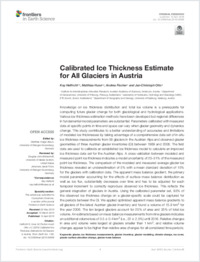Calibrated ice thickness estimate for all glaciers in Austria
- Helfricht, Kay Institute for Interdisciplinary Mountain Research, Austrian Academy of Sciences, Innsbruck, Austria
- Huss, Matthias Department of Geosciences, University of Fribourg, Switzerland - Laboratory of Hydraulics, Hydrology and Glaciology (VAW), ETH Zurich, Switzerland
- Fischer, Andrea Institute for Interdisciplinary Mountain Research, Austrian Academy of Sciences, Innsbruck, Austria
- Otto, Jan-Christoph Department of Geography and Geology, University of Salzburg, Austria
- 12.04.2019
Published in:
- Frontiers in Earth Science. - 2019, vol. 7, p. 68
English
Knowledge on ice thickness distribution and total ice volume is a prerequisite for computing future glacier change for both glaciological and hydrological applications. Various ice thickness estimation methods have been developed but regional differences in fundamental model parameters are substantial. Parameters calibrated with measured data at specific points in time and space can vary when glacier geometry and dynamics change. This study contributes to a better understanding of accuracies and limitations of modeled ice thicknesses by taking advantage of a comprehensive data set of in-situ ice thickness measurements from 58 glaciers in the Austrian Alps and observed glacier geometries of three Austrian glacier inventories (GI) between 1969 and 2006. The field data are used to calibrate an established ice thickness model to calculate an improved ice thickness data set for the Austrian Alps. A cross-validation between modeled and measured point ice thickness indicates a model uncertainty of 25–31% of the measured point ice thickness. The comparison of the modeled and measured average glacier ice thickness revealed an underestimation of 5% with a mean standard deviation of 15% for the glaciers with calibration data. The apparent mass balance gradient, the primary model parameter accounting for the effects of surface mass balance distribution as well as ice flux, substantially decreases over time and has to be adjusted for each temporal increment to correctly reproduce observed ice thickness. This reflects the general stagnation of glaciers in Austria. Using the calibrated parameter set, 93% of the observed ice thickness change on a glacier-specific scale could be captured for the periods between the GI. We applied optimized apparent mass balance gradients to all glaciers of the latest Austrian glacier inventory and found a volume of 15.9 km3 for the year 2006. The ten largest glaciers account for 25% of area and 35% of total ice volume. An estimate based on mass balance measurements from nine glaciers indicates an additional volume loss of 3.5 ± 0.4 km3 (i.e., 22 ± 2.5%) until 2016. Relative changes in area and volume were largest at glaciers smaller than 1 km2, and relative volume changes appear to be higher than relative area changes for all considered time periods.
- Faculty
- Faculté des sciences et de médecine
- Department
- Département de Géosciences
- Language
-
- English
- Classification
- Hydrology
- License
-
License undefined
- Identifiers
-
- RERO DOC 326746
- DOI 10.3389/feart.2019.00068
- Persistent URL
- https://folia.unifr.ch/unifr/documents/307924
Statistics
Document views: 142
File downloads:
- pdf: 213
